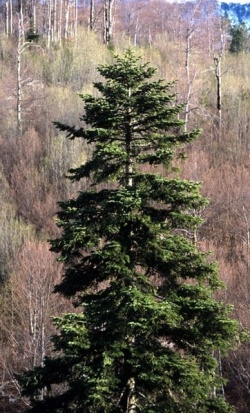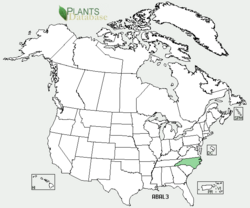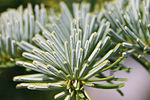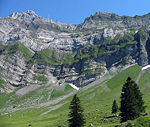Silver fir
| Silver fir |
|---|

|
| Scientific Classification |
|
| Binomial Name |
|
Abies alba |
The Silver Fir (Abies alba), is part of the family Pinaceae or the Pine family. It is an evergreen tree native to central Europe that can reach heights of up to 80 feet, but usually found with heights of around 60-70 feet. Its name was derived from the underside of its needles, which are white, making the tree look silver when viewed from below.
The Silver Fir was one of the first Christmas trees ever used, but because of its size it was replaced by smaller trees. It has also been used for medical purposes such as cures for the common cold, and is edible.
Anatomy
The Silver Fir is a narrow-leaved evergreen tree that can grow to be as tall as 80 feet. The annual growth rate is less than 12 inches per year. [1] The bark is gray and scaly. The needles are green on the top while the underside has a white appearance which is caused by stomata (tiny leaf pores that let carbon dioxide enter the needle and allow oxygen and water vapor to leave). When looked at from below, the tree looks white. The needle base looks twisted while the end is notched and rounded. The tree produces buds that are brown, then produces seed cones that are green when they are young but as they grow older they become a reddish brown. [2]
Reproduction
Silver Firs are gymnosperms, which means that they produce “naked seeds”. Silver Firs produce two types of cones. The male cone is called the pollen cone and the female cone, which is larger, is the seed cone. The spore producing structures are found on the scales of cones.[3] Microspores are formed on the sporophylls on the male and female cones. Each scale in the male cone has two sporangia, once meiosis occurs, spores are produced. Male gametophytes start developing in the microspore, also known as the pollen grain. The sporangium opens and lets go of the immature gametophytes. These gametophytes are carried in the wind until they arrive at a sporophyll on a female cone. The mature seed consists of the seed coat and nucellus (which feeds the embryo as it grows), and the embryo. After around two years the mature seeds can be shed. [4]
Ecology
The Silver Fir is native to central Europe’s Ukraine's Karpaty Mountains. It can also found in Belarus, Asia and the Caucasus Mountains. They prefer to live in habitats with fresh and moist soils that can be found at higher altitudes. [5] Silver Fir prefers moist but not over watered soil. It needs a generous amount of rainfall in order to survive. Silver Firs do not do well in windy areas. They live in most soils except sands and peats. They also grow well in heavy clay soils. These trees are slow growing for the first few years, but once they reach 5-6 feet they begin to grow at a steadier rate than before, about 12 inches annually. The Silver Fir does not do well in hot or dry areas, because it relies so much on water.[6]
Uses
The silver fir has many different uses. For example the bark can be used as a medicine and also as a edible dish.
Medical:
The Silver Fir has many medical uses. The buds are antibiotic, antiseptic and balsamic, the needles can be used as a sedative. They are best if harvested in the spring and can be dried and used later. The bark is an antiseptic and can be harvested throughout the year. The needles are also used as ingredients in remedies for colds and coughs, either taken internally or used as an inhalant. The resin can be used in bath extracts, and rubbing oils for treating pains. [7]
Edible:
The inner bark can be cooked and then eaten. It can also be dried, then ground into a powder and used to thicken soups. It can also be used when making bread. [8]
General:
Resin is taken from trees around 60 - 80 years old and is used for oil. The resin extracted from the silver fir is used in perfume, and caulking ships. The resin is also referred to as "Strasburg Turpentine". The oil of turpentine is an important ingredient in the making of paint. Another part of the resin is used to make varnishes. The wood of this tree is preferred for its lightness. The wood is used in construction, furniture, and boxes.[9]
 Browse |
References
- Abies Alba- Silver Fir by Michigan State University
- Silver Fir (Pine Family) by Lakehead University
- Life Cycle by msnucleus
- Gymnosperms by Michael Knee, Ohio State University
- Medicinal Information by Calvin Wills
- Cultivation Notes by Calvin Wills
- General Uses by Calvin Wills
- Edible Uses by Calvin Wills



